Middle Eastern vegetables are those that are widely cultivated and consumed in the Middle East. This region typically includes West Asia and Egypt, but I also expand the scope to North Africa due to the culinary connections between the two regions.
The Middle East is home to many globally popular vegetables. Many local vegetables were spread from this region to Europe and the rest of Asia, and vice versa.
Many dishes in Middle Eastern cuisine are based on vegetables, especially salads, stews, stuffed dishes, and grilled dishes. Certain local beverages also include vegetables, although they are less common than vegetable dishes.
Continue reading to discover the best 24 vegetables in the Middle East and the general characteristics of local vegetables.
Next, I will delve into popular dishes and beverages made with vegetables and suggest a few common Middle Eastern fruits.
24 Incredible Middle Eastern Vegetables with Filters
Here are 24 popular Middle Eastern vegetables, listed by popularity. You can use filters to see which ones are native, which are not originally from the region, and which are considered fruit vegetables.
The filters also help you find out which vegetables are commonly used in dishes, drinks, or as garnishes.
Tomato
- For Dishes
- Fruit Vegetables
- Non Native
Tomato is among the most essential vegetables in Middle Eastern cuisine. Technically a berry fruit, it is mainly used as a vegetable in salads, grilled dishes, stews, broths, dips, and many other dishes.
Interestingly, tomatoes aren’t a traditional local vegetable as they originated in South America. Europeans brought them to the region in the 18th or even 19th century, after which tomatoes completely transformed Middle Eastern cooking.
Middle Eastern tomatoes sport a smooth, red skin and a juicy, slightly sweet taste. While this vegetable grows well in the region’s warm climate, many countries have to import tomatoes from other countries to satisfy their demands, such as Iraq and Saudi Arabia.
Cucumber
- For Dishes
- For Garnish
- Fruit Vegetables
- Native
Cucumber is a favorite vegetable of many Middle Eastern countries. In its raw form, it offers high water content (up to 95%), a satisfying crunch, and a refreshing sweetness with a hint of bitterness.
These traits make cucumbers a vital ingredient in many cooling dishes, especially dips and salads based on yogurt. There are three main types of cucumbers: slicing, pickling, and seedless cucumbers.
Similar to tomatoes, cucumbers are classified as a berry fruit. But unlike tomatoes, cucumbers have a long history in local cooking traditions; it was spread to the Middle East from India at least 3,000 years ago.
Onion
- For Dishes
- For Garnish
- Native
Onion is an iconic vegetable in the Middle East, which also claims one of the earliest records of onion cultivation in the world. Grown throughout the region, it is mainly eaten raw in salads, sautéed, caramelized, or used as a base for soups and stews.
Each onion has a signature pungent taste, varying from strong and hot to sweet, bitter, acidic, earthy, or salty. The colors also range widely, with white, pale yellow, orange, pink, and purple being popular hues.
There are three main onion varieties in the Middle East: the Egyptian, the Syrian, and the Lebanese. The yellow-hued Egyptian and Syrian onions are small, sweet, and perfect for raw consumption, whereas the Lebanese one has large green bulbs.
Here’s a tip when dealing with larger onions: remove the first chewy layer after peeling the skin for the best results.
Eggplant
- For Dishes
- Fruit Vegetables
- Non Native
Eggplant is one of the most versatile vegetables in Middle Eastern culinary tradition. Like many popular vegetables in the region, it is actually a berry fruit with an egg-like shape and spongy, meaty texture.
Native to India, eggplants were first cultivated in the Middle East at an early time and spread throughout the Middle East during the Muslim conquests in the 7th and 8th centuries. While their inner flesh is white, their exterior is deeply purple.
The spongy texture of eggplants absorbs flavors well, so this fruit vegetable is a widely used ingredient for various baked and stuffed dishes. Roasted or grilled eggplants also have great uses in dips and spreads.
Bell Pepper
- For Dishes
- Fruit Vegetables
- Non Native
Bell pepper is a colorful vegetable that people in the Middle East use in many kinds of dishes, including grilled, roasted, sautéed, and stuffed delights. Its main hues include red, yellow, orange, green, and purple shades.
In reality, bell peppers don’t fall into any vegetable category but are a type of berry fruit. Hailing from the Americas, they arrived in the Middle East around the mid-17th century through trade with the Europeans.
Bell peppers add a satisfying bite to any dish since they have a wonderfully crunchy texture. Their flavors range from slightly bitter and grassy to sweet and fruity notes, with red bell peppers generally considered the most mellow in taste.
Garlic
- For Dishes
- Native
Garlic is an essential vegetable in the Middle East because it imparts a powerful, spicy, and earthy taste to various local dishes. Native to Central Asia and South Asia, it reached the ancient civilizations in the region at least five millennia ago.
However, some theories suggest that the precursors of modern garlic were indigenous to the Middle East. In ancient Egypt, garlic was used not only as a form of currency to pay pyramid workers but also was placed in the tombs of pharaohs.
In the modern day, garlic is a must-have cooking ingredient in many Middle Eastern recipes, especially stews, dips, sauces, and marinades. Raw garlic is quite pungent, but it mellows into a nutty and slightly sweet flavor upon cooking.
Chickpea
- For Dishes
- Native
Chickpea is one of the oldest cultivated legumes in the Middle East and the world. It was domesticated in the region near south-eastern Turkey and Syria about 7,500 years ago.
Chickpeas offer a mild, nutty flavor tinged with a hint of earthiness. Their colors range from green when plucked early to hues of tan, beige, and even dark brown to black.
People in the Middle East mainly use chickpeas in stews, salads, dips, and soups. These legumes can be cooked whole or mashed into a creamy spread.
There are two main chickpea varieties: kabuli (large and mostly white) and desi (smaller and available in many colors). The former is very popular in the Middle East and the Mediterranean, while the latter is grown in the rest of the world.
Lentil
- For Dishes
- Native
Lentil is a traditional legume in the Middle East, which witnessed its domestication at least 7,500 years ago. It comes in many colors, from slate green, brown, and black to reddish-orange, coral, and gold.
Small, lens-shaped lentils grow well in the semi-arid conditions of the Middle East, providing a neutral yet pleasantly nutty flavor. They are commonly used in soups, salads, and stews, while ancient Egyptians even prepare lentil bread.
Since lentils are easy to grow and have an excellent shelf life, they are a stable food source for many people in the region.
Zucchini
- For Dishes
- Fruit Vegetables
- Non Native
Zucchini is a mildly sweet summer squash widely utilized in Middle Eastern cuisine in both raw and cooked forms. The contrast of its dark green, crunchy skin against the soft, pale yellow flesh is striking.
As a fruit vegetable of New World origin, zucchini was introduced to the Middle East centuries ago via European contacts. Today, this versatile vegetable is a common sight throughout the region, especially during the spring and summer months.
Among the many ways I’ve savored zucchini in the Middle East, the stuffed version is my favorite, followed by zucchini-based baked dishes
Carrot
- For Dishes
- Native
Carrot is a popular root vegetable in the Middle East. Domesticated around the 10th century in Persia, it later spread throughout the region, even gaining a foothold in Southern Europe as the Moors expanded their realm.
Many people automatically think of carrots as being orange, but the numerous Middle Eastern varieties offer more colors, such as purple, red, and yellow. All these variations can be enjoyed raw as part of salads or snacks and cooked in stews, soups, and sweet desserts.
This root vegetable thrives best in cooler weather, so winter and spring are its peak seasons. Dominant carrot producers in the Middle East are Turkey, Iran, and Israel.
Potato
- For Dishes
- Non Native
Potato is a beloved starchy root vegetable in the Middle East. It has been fully integrated into local cuisine since its introduction in the 17th century.
With a mealy, waxy, sloughing, or firm texture, potatoes boast an earthy and starchy taste, creating a comforting base for many dishes. This flavor profile goes particularly well with various Middle Eastern spices.
Middle Eastern potatoes come in different sizes and varieties. The yellow variants have thin, gold skin with yellow flesh, whereas the red-skinned one offers a pale interior, and there are also white-skinned potatoes and exotic purple or blue ones with matching flesh.
Spinach
- For Dishes
- For Garnish
- Native
Spinach is a common leafy vegetable in the Middle East. First grown in ancient Persia, it is part of many traditional vegetable dishes, especially salads and stews.
Spinach is full of alternate, simple leaves in an ovate or triangular shape. You can munch on these leaves fresh or preserve them through canning, freezing, or dehydration.
Raw spinach has a mild and slightly sweet taste, but cooking brings out a more acidic and robust flavor and also makes the vegetable easier to digest.
Fava Bean
- For Dishes
- Native
Fava bean is a creamy, nutty, and sweet legume that is present in numerous Middle Eastern kitchens. It is endemic to the Eastern Mediterranean, which overlaps with Levantine countries, such as Israel, Jordan, and Lebanon.
Many other Middle Eastern countries also use fava beans in their food. In Iran, fava beans accompany rice, while they add a delightful crunch to salads in Turkey.
In addition, fava beans are the main ingredient of various wholesome soups and stews. They are typically harvested in late spring and are widely available throughout summer and fall.
Squash
- For Dishes
- Fruit Vegetables
- Non Native
Squash is a well-liked vegetable in the Middle East. It includes many varieties, from elongated and green fruits, like zucchini, to bulbous shapes.
Most types of squash are mild and slightly sweet, and they can be eaten raw in salads, grilled, stuffed, or used in soups and stews. Hailing from the Americas, they are now a cornerstone of the Middle Eastern cooking tradition.
Of the main squash varieties in the region, the Cousa Magda is an outstanding summer squash that is available from June through summer. It is a blocky, pale-green, tapered fruit with a sweet, nutty taste.
Cabbage
- For Dishes
- Native
Cabbage is a sought-after Middle Eastern leafy vegetable. This region, especially Asia Minor, is one of the birthplaces of cabbage, which typically weighs between 1 and 2 pounds and is cultivated for its dense-leaved heads.
Middle Eastern cabbage comes in two main varieties: white and red. White cabbage is excellent for braising or cooking, while red cabbage is perfect for quick dishes or chopped into small pieces for spicy recipes.
Both white and red cabbage varieties deliver a fresh and peppery flavor that pairs well with meat dishes. Their crisp texture is ideal in salads, pickles, and stews.
Okra
- For Dishes
- Fruit Vegetables
- Native
Okra, known in Arabic as “bamia” or “bamya,” is a capsule-shaped vegetable widely enjoyed throughout the Middle East. Its cultivation spread from tropical Africa to ancient Egypt, from which it was introduced to the rest of the region.
Well-suited to the warm climates of the Middle East, okra plants bear numerous pod-like fruits that are used as vegetables. These tapered pods are green and contain edible seeds.
Okra’s flavor is a mild and grassy blend of green beans and asparagus with an earthy undertone. When cooked, they release a slimy substance that helps thicken stews and soups.
In case you dislike the viscosity of okra, soak this vegetable in vinegar before cooking it helps reduce the slime.
Chard
- For Dishes
- Native
Chard, also known as Swiss chard in English, is a vibrant green leafy vegetable in Middle Eastern cuisine. Locals often use it in salads, stir-fries, wraps, and stuffed dishes.
Chards are cultivated along the Mediterranean coast, which is the birthplace of this green. Their leaves are large, with a bitter and earthy taste, while the thick, crunchy stalks are more neutral.
To make chards more delicious, boil the leaves and stalks to reduce the bitterness and enhance their natural flavor.
Turnip
- For Beverages
- For Dishes
- For Garnish
- Native
Turnip is a favored Middle Eastern root vegetable that is purple and white in color. Every part of it is edible, from the roots to the leaves (called turnip greens).
Research suggests that modern turnips first appeared in West Asia, Central Asia, and Europe. Many ancient cultures in the Middle East had turnips among their vegetable offerings.
Turnips taste similar to potatoes but with a crunchier texture and an extra peppery flavor. People in the Middle East love adding them to stir-fries or salads and pickles that are served on the side of grilled meat.
Beet
- For Dishes
- For Garnish
- Native
Beet, also known as beetroot, refers to the taproot portion of the beet plant and is a well-liked root vegetable in the Middle East. Originating from this region, the root vegetable boasts a history spanning thousands of years in local cuisine.
Although both the leaves and the taproot of a beet are edible, the latter is the more preferred version due to its earthy and slightly sweet taste.
Beets with a stunning reddish-purple hue are the most popular variety in the Middle East, although they can also come in white, golden, or even a rainbow of colors.
Like inhabitants in other regions, people in the Middle East consume beets in their raw, roasted, pickled, and boiled forms. This vibrant root vegetable is also part of dips, salads, and side dishes.
Radish
- For Dishes
- For Garnish
- Native
Radish is a versatile root vegetable that appears in many Middle Eastern dishes. It has a long history in the region, as records show that Egyptians knew how to cultivate it before the construction of the pyramids.
Radishes come in many sizes and colors, with white, purple, and red varieties being very common. However, the signature intense, spicy flavor and crispy, crunchy texture of raw radishes are the most notable characteristics.
People in the Middle East usually add thin slices of raw radishes to salads or meze platters (snacks and appetizers), though pickled radishes are also a wonderful condiment and side dish.
Parsnip
- For Dishes
- Native
Parsnip is a popular root vegetable in the Middle East. A close cousin to carrot and parsley, it is similar to a cream-colored carrot, boasting a long, tapered shape with a sweet, mildly pepper taste.
Native to the Eastern Mediterranean, parsnips thrive in cooler climates and are harvested in the late fall or early winter. Raw parsnips are a perfect addition to salads, but roasting, stewing, or cooking them in soup can take their sweetness and earthiness to the next level.
Kale
- For Dishes
- For Garnish
- Non Native
Kale is the main element of many salad bowls in Middle Eastern cuisine. Its crunchy green or purple leaves offer a strong, earthy flavor with faint notes of bitterness.
The Eastern Mediterranean and Asia Minor are home to the original kale, the latter corresponding to modern-day Turkey. However, the usage of this leafy vegetable in Middle Eastern cuisine is relatively modern.
More and more people use kale in salads and smoothies. With an incredibly high level of vitamins and minerals, kale is bound to receive more recognition in the future.
Celery
- For Dishes
- For Garnish
- Native
Celery is a well-known leafy vegetable in Middle Eastern cuisine. Since it originated in the Mediterranean, it is more popular in countries along the coastline.
The crisp, fibrous stalks and leafy tops are the most valuable celery parts, both of which have a clean, bitter taste. The leaves also come with strong aromas and can be used as a herb.
Celery is a flavorful addition to various Middle Eastern soups, stews, and salads. Meanwhile, celery seeds can be ground to use in spice blends or traditional medicine.
Ginger
- For Beverages
- For Dishes
- Non Native
Ginger is a spicy root vegetable that is featured in many Middle Eastern countries as a spice. Domesticated by ancient Southeast Asians, it found its way to the region through trade about two millennia ago.
Ginger grows in warm climates, and its knotty, fibrous rhizome (horizontal underground plant stem) is the edible part. The exterior ranges from yellow to brown, while the interior is yellowish-white and delivers a hot, zest, and slightly sweet taste.
Fresh and dried ginger is an excellent seasoning for meat dishes, soups, and sweets. This fragrant vegetable is also a key ingredient in many spice mixes, herbal teas, and beverages with digestive benefits.
Now that you know about the most famous vegetables in the Middle East, let’s look at the characteristics they all share.
Now that you know about the most famous vegetables in the Middle East, let’s look at the characteristics they all share.
What Are the Main Features of Middle Eastern Vegetables?
Below is an overview of the most important factors contributing to the development of vegetables in the Middle East.
Diversity
Since the Middle East offers a wide range of climates and geographical features, it is home to many different kinds of vegetables, including leafy greens, root vegetables, and legumes. From the Mediterranean coast to the desert interior, there are many different vegetables available.
In addition, the Middle East sits at the crossroads of many large geographical regions, so vegetables from many places were brought here in ancient times and became integrated into local cuisine.
Heirloom Varieties
Many vegetables used in Middle Eastern cuisine are heirloom varieties that have been cultivated for generations. These varieties are often more flavorful and nutritious than their commercially grown counterparts.
Culinary Traditions
Middle Eastern vegetables are used in various ways, such as in stuffed dishes, grilled dishes, salads, pickles, and dips. In particular, stuffed vegetables are a cornerstone of Middle Eastern cuisine.
Continue reading for an in-depth understanding of how Middle Eastern dishes feature vegetables.
Which Middle Eastern Dishes Make Use of Vegetables?
The following Middle Eastern dishes highlight the wonderful flavors and textures of local vegetables.
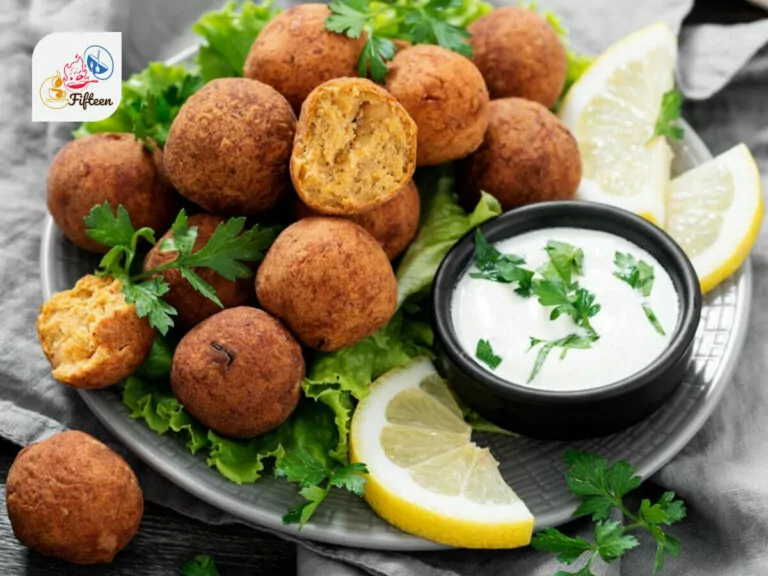
Falafel
Falafel is a traditional Middle Eastern dish in the form of deep-fried balls or patties made from ground chickpeas, fava beans, or a combination of both.
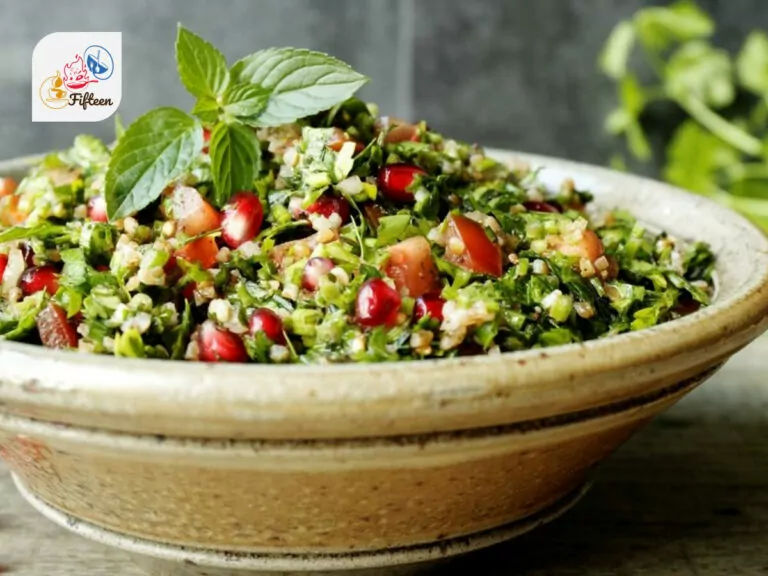
Tabbouleh
Tabbouleh is a Middle Eastern vegetarian salad prepared by mixing finely chopped parsley, mint, tomatoes, onions, and bulgur (parboiled and cracked wheat) in a mixture of olive oil and lemon juice.
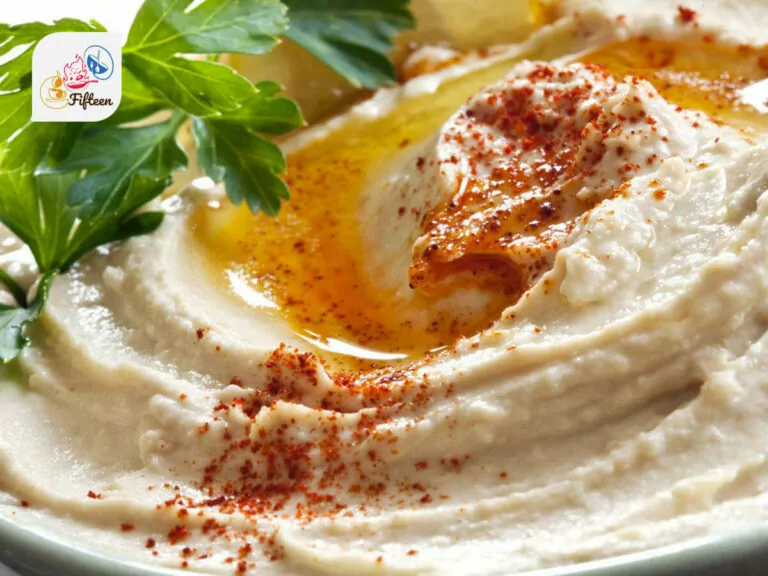
Hummus
Hummus is a traditional Middle Eastern spread or dip made from mashed chickpeas, tahini (sesame paste), lemon juice, garlic, olive oil, and spices like paprika.
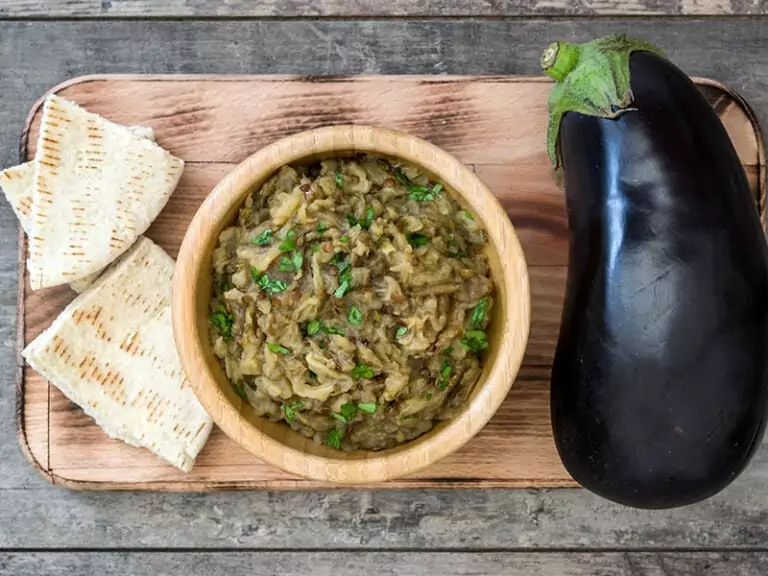
Baba Ganoush
Baba ghanoush is a classic Middle Eastern appetizer made from roasted eggplants, tahini, olive oil, lemon juice, and various seasonings.
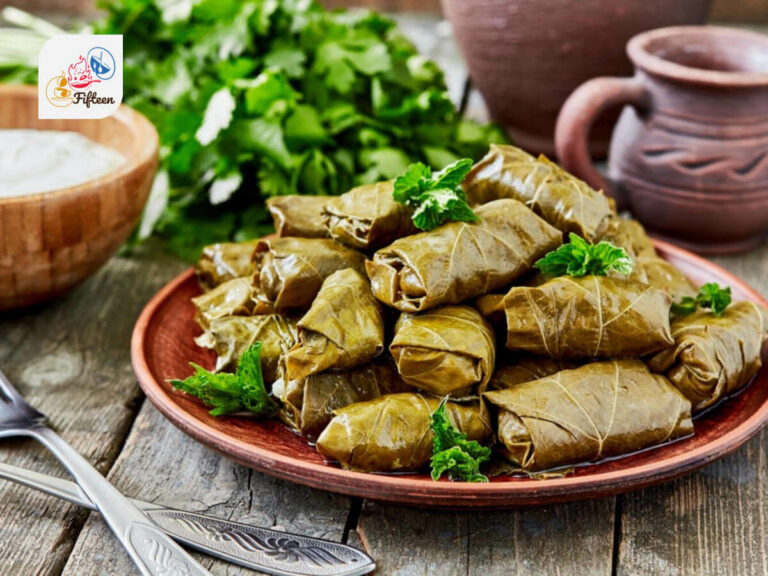
Dolma
Dolma refers to a family of stuffed dishes popular in the Middle East. People prepare it by stuffing bell peppers, tomatoes, zucchini, and eggplants with a mixture of rice, meat, and spices or wrapping grape and cabbage leaves around the filling.
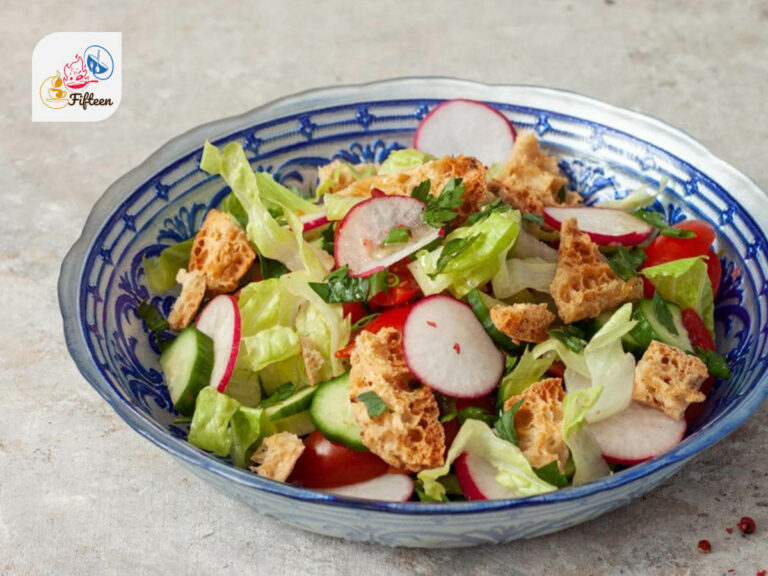
Fattoush
Fattoush is a vibrant Middle Eastern salad that combines toasted or fried khubz (Arabic flatbread) with fresh greens and vegetables, such as radishes and tomatoes.
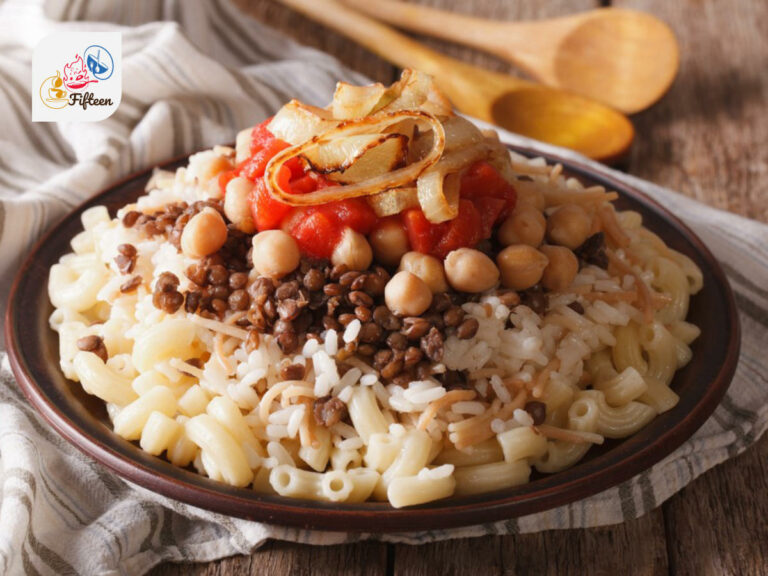
Koshary
Koshary is an Egyptian street food delight that consists of rice, macaroni, and lentils topped with a spicy tomato sauce, chickpeas, and crispy fried onions.
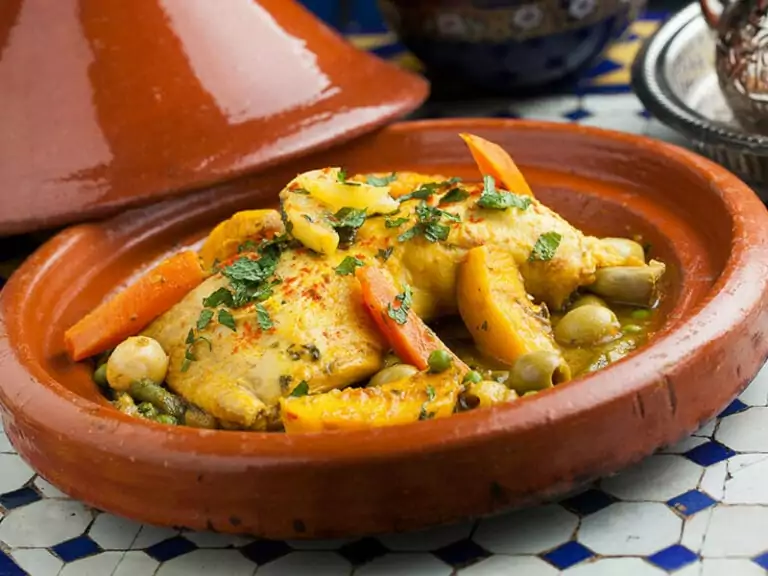
Tajine
Tajine is a time-honored North African that includes protein (meat, poultry, or fish), fried fruits, and vegetables, such as tomatoes, carrots, and potatoes.
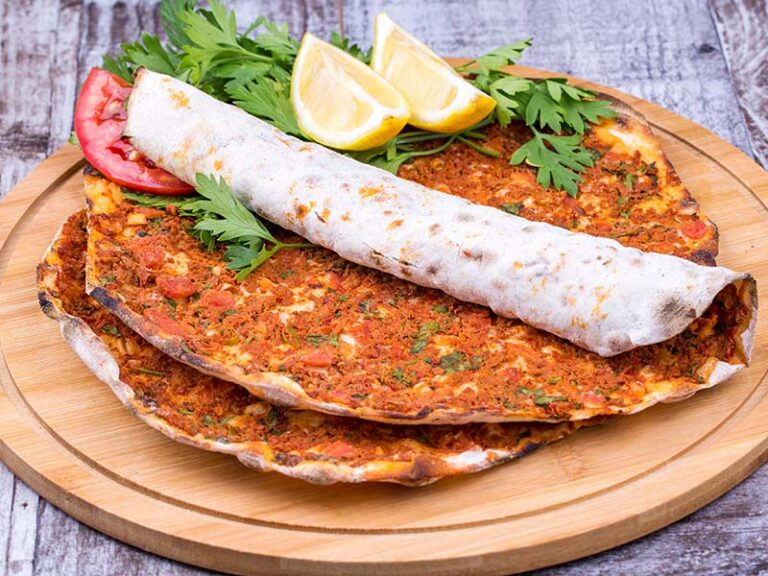
Lahmacun
It is a popular flatbread dish in the Middle East, especially in the Levant. It has a dough base topped with minced beef or lamb, herbs, and minced vegetables, including onions, garlic, and tomatoes.
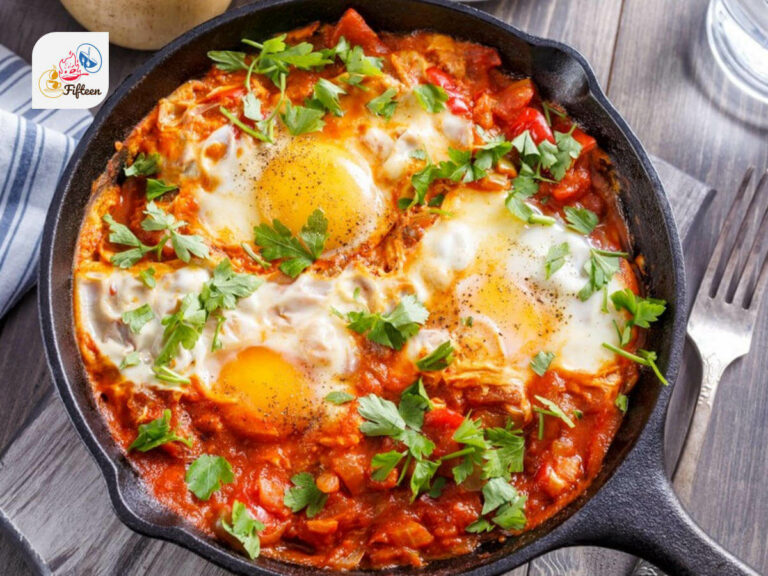
Shakshouka
Shakshouka, also known as shakshuka, is a savory Middle Eastern dish and breakfast item featuring eggs poached in a sauce of tomatoes, onions, peppers, and spices.
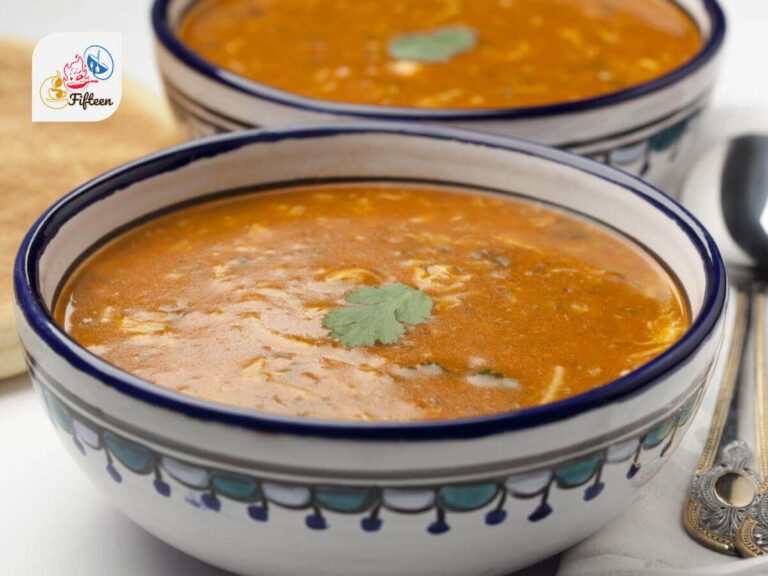
Harira
Harira is a North African soup of tomatoes, lentils, chickpeas, onions, rice, and meat, all together with spices in a flavorful broth.
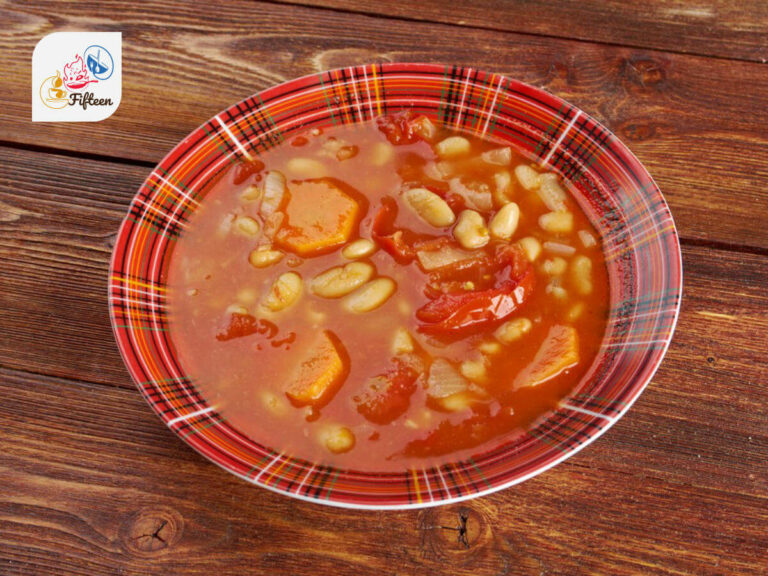
Fasolada
Fasolada, also known as fasoulada or fasoulia, is a traditional Cypriot soup made from dry white beans, olive oil, and vegetables like carrots, onions, celery, and tomatoes. It is also present in many Middle Eastern countries.
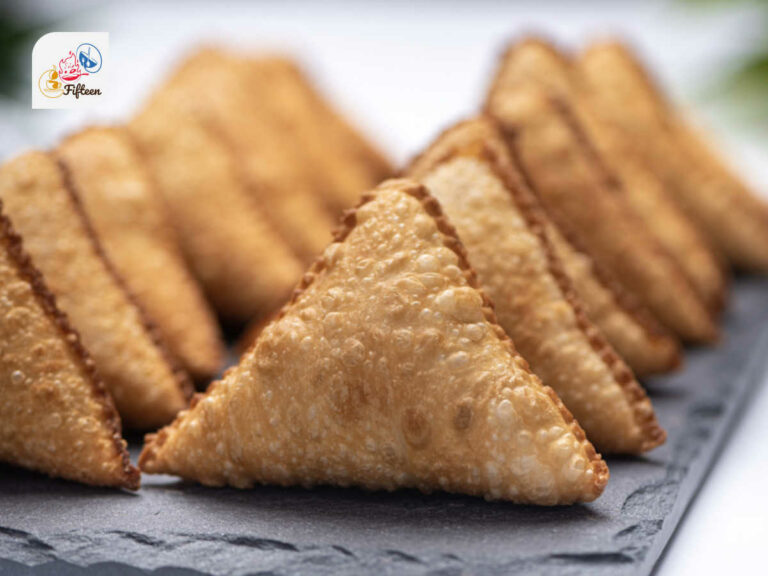
Samosa
Samosa is a stuffed fried pastry widely enjoyed in many regions, including the Middle East. Its filling features spiced potatoes, onions, peas, and sometimes meat or fish.
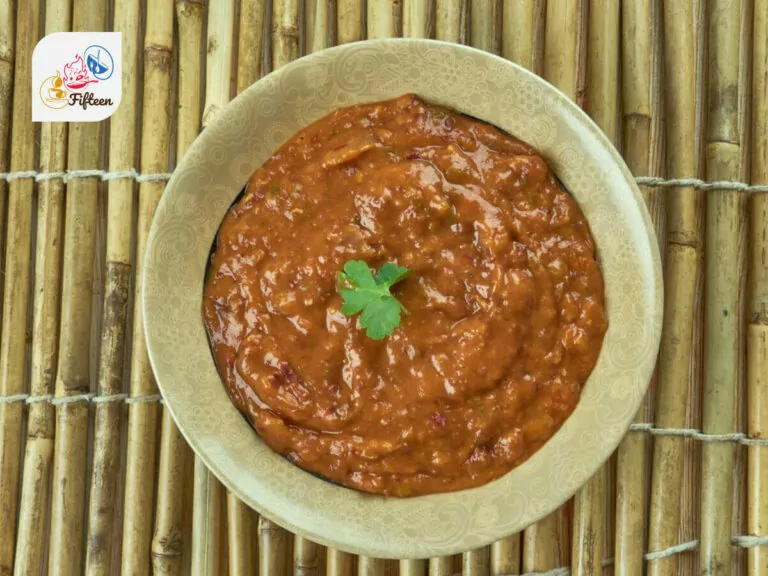
Ful Medames
Ful medames is an iconic Egyptian stew prepared by cooking mashed fava beans with olive oil, cumin, garlic, onion, lemon juice, and herbs.
If you want to try more flavors of local cuisine, there are many other Middle Eastern specialties worth discovering out there.
Do you know that a few Middle Eastern beverages are based on vegetables? Check out these options next!
What Are Middle Eastern Beverages That Incorporate Vegetables?
The following beverages are delicious drinks that feature vegetables either as the main ingredient or as the flavoring.
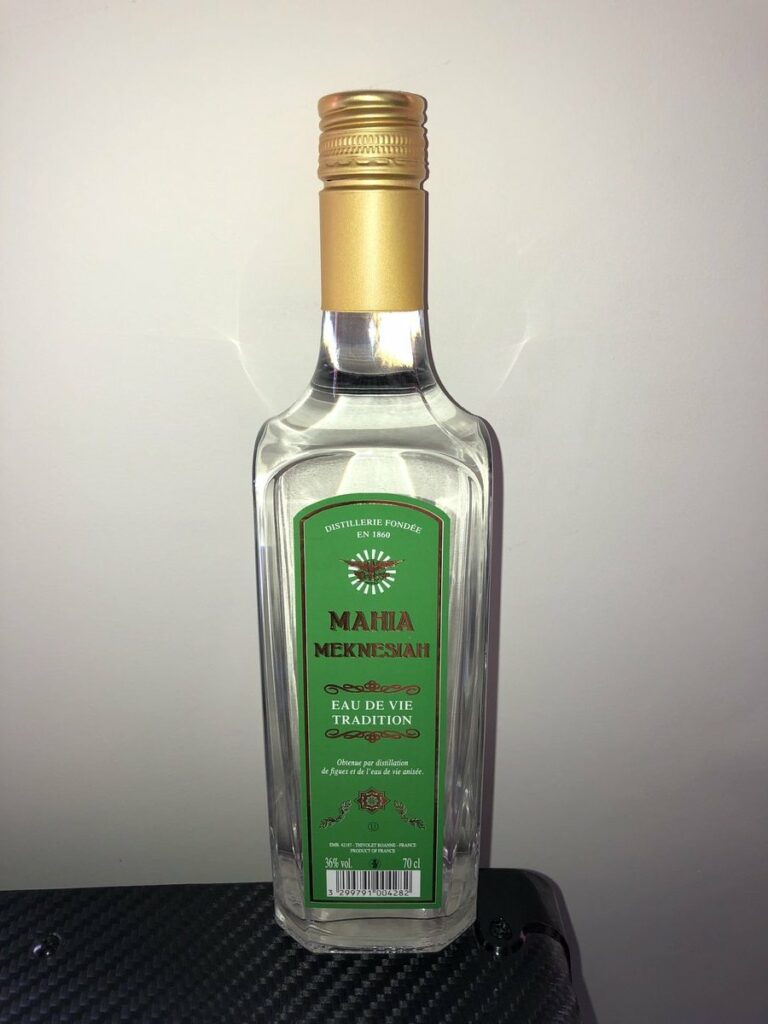
Mahia
Mahia is a Moroccan alcoholic made from dates or figs, pomegranate juice, anise seeds, rose water, ginger syrup, and pomegranate juice.
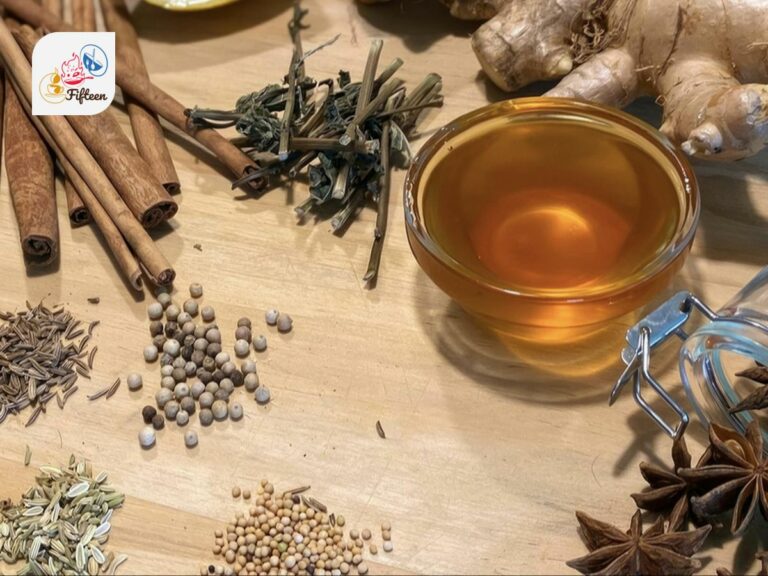
Khunjul
Khunjul is a well-known spiced tea drink in Morocco, blending ginger, galangal, cinnamon bark, cloves, mace, and other aromatic ingredients.
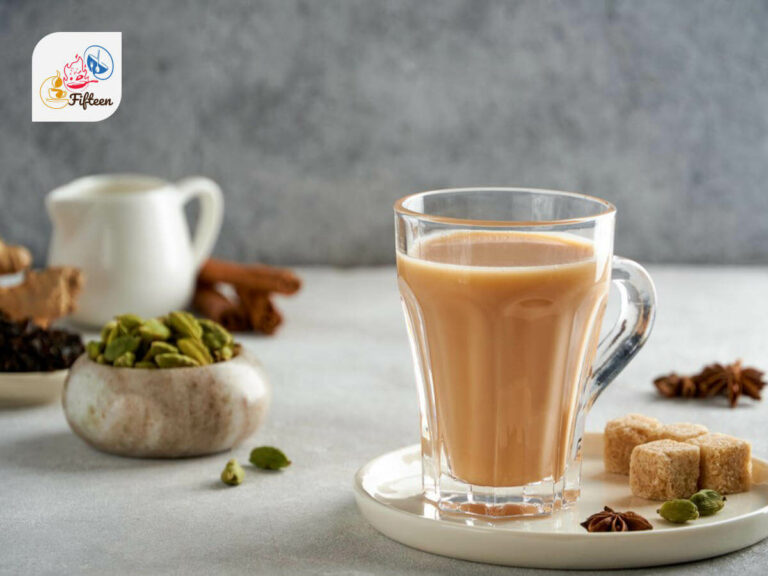
Chai
Chai is a popular type of Iranian tea made with loose black tea and flavored with ginger, cloves, cinnamon, and cardamom.
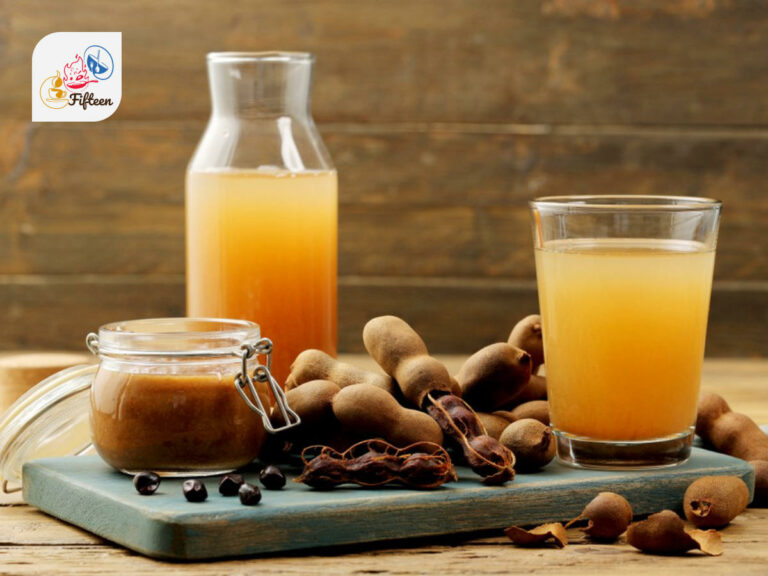
Tamer Hindi
Tamer hindi is a refreshing Middle Eastern beverage made with tamarind paste, sugar, rose water, and ginger juice.

Ayran
Ayran is a famous yogurt-based beverage in the Middle East. Locals usually add spices and cucumbers to balance its tang and richness.
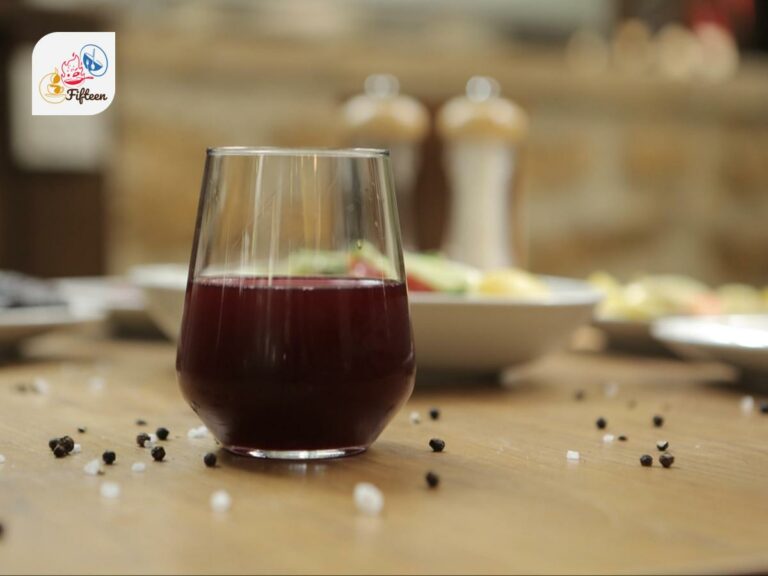
Şalgam
Şalgam is a Middle Eastern fermented beverage combining turnips, water, black carrots, bulgur flour, and salt.
Of course, those drinks aren’t the only options on the list of the best beverages in the Middle East. Explore this topic, and you will discover more refreshing beverages.
Fruits and vegetables often appear together in many Middle Eastern meals, so I will show you a few notable fruits in the region.
Which Fruits Are Well-known in the Middle East?
Wherever you are in the Middle East, I’m certain you will run into the following fruits because they are ubiquitous in the region.
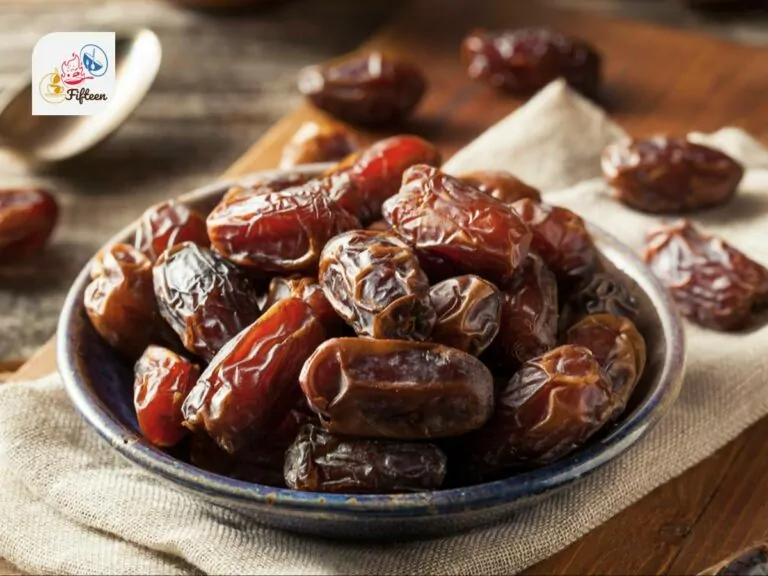
Date
Date is among the most culinarily and culturally significant fruits in the Middle East, offering a deeply sweet flavor and chewy texture.
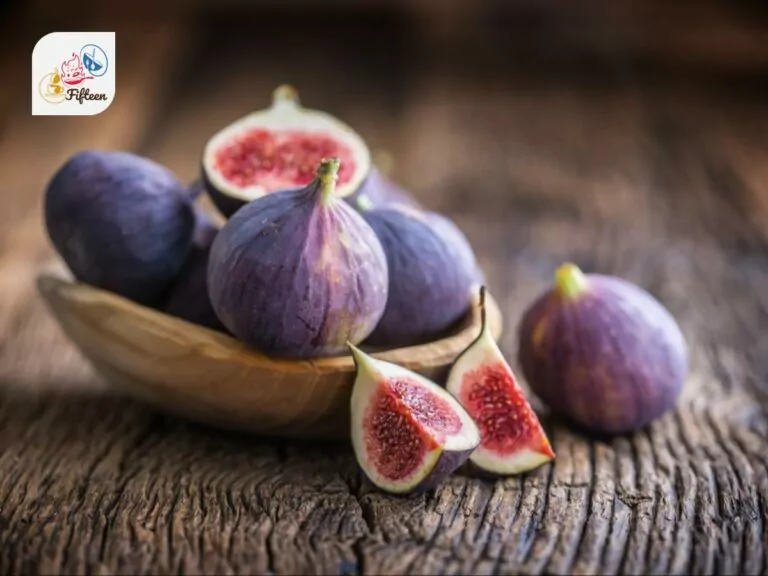
Fig
Fig is a juicy Middle Eastern fruit with crunchy edible seeds and a honeyed taste.
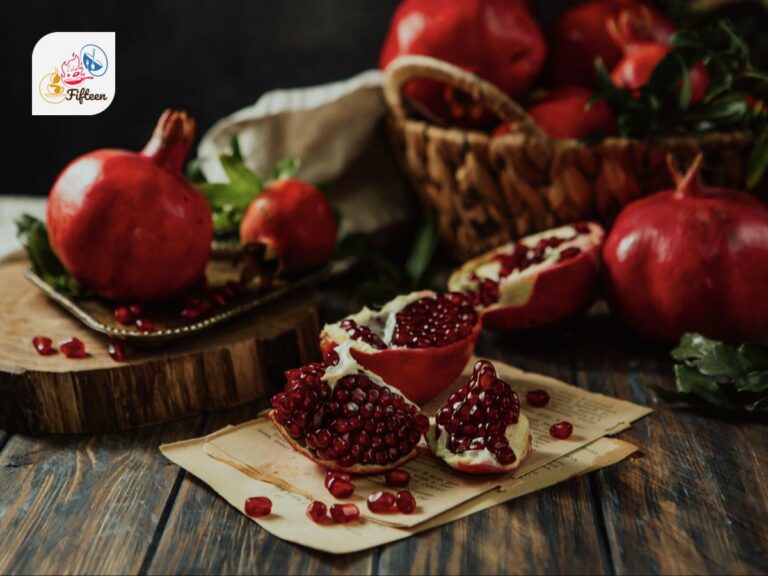
Pomegranate
Pomegranate is a popular Middle Eastern red fruit with sweet, juicy arils. It is used in making pomegranate juice and pomegranate molasses.
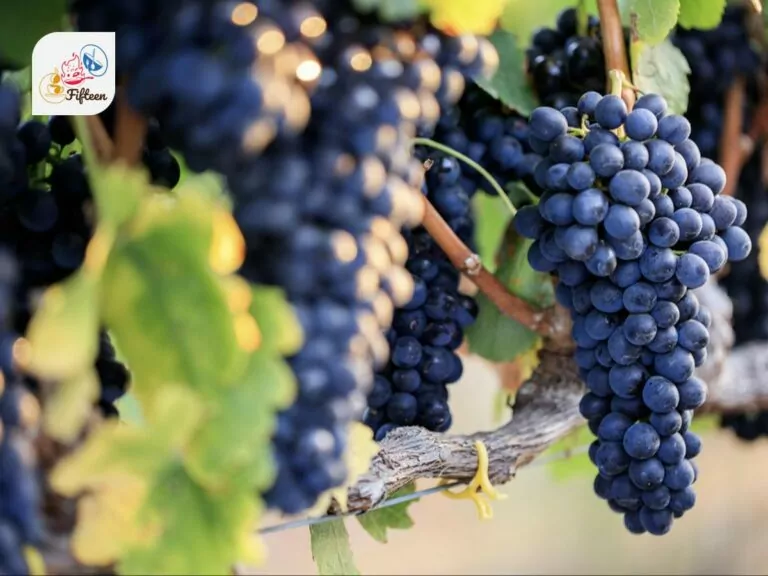
Grape
Grape is a common berry fruit with many uses in the Middle East. Locals mainly utilize them in making wine and raisins.
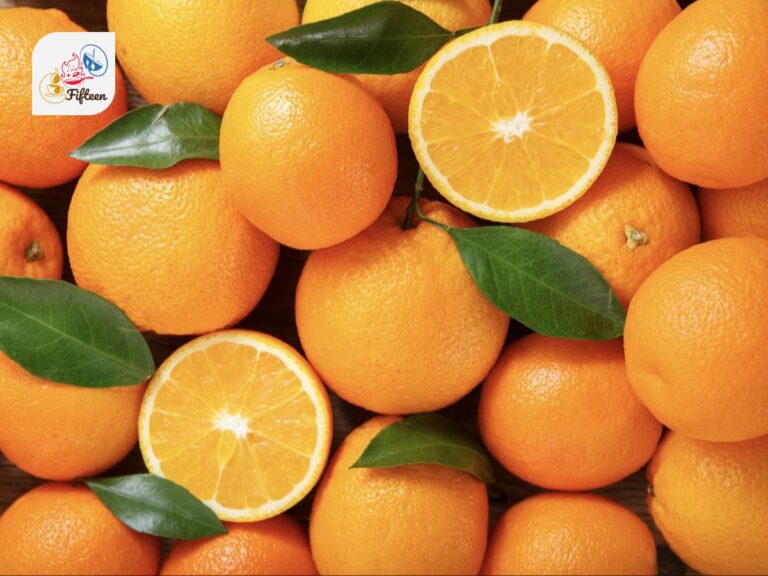
Orange
Orange is one of the most popular citrus fruits in the Middle East, serving as a common ingredient in local dishes and beverages.
The options above are the most popular fruits in the Middle East. Many other fruits aren’t on this list, but they are also worth learning about.
How many vegetables from the Middle East that you are familiar with? Share with me your experience with those vegetables in the comment section; I’m all ears for your tale! Before you leave, don’t forget to share this list of Middle Eastern vegetables with your friends!


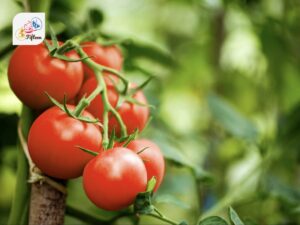
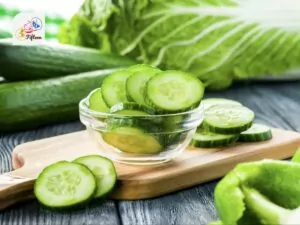
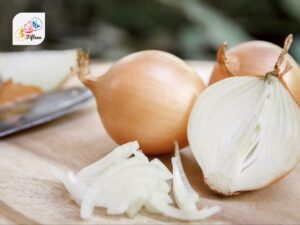
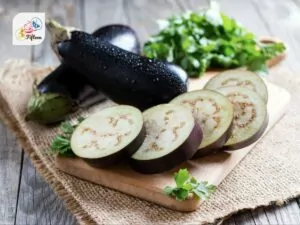
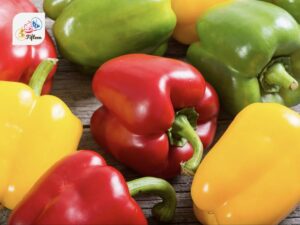
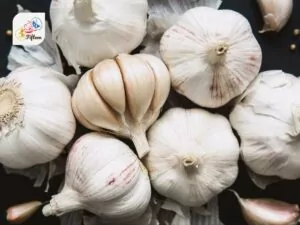
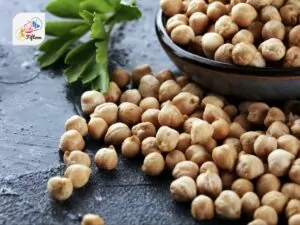
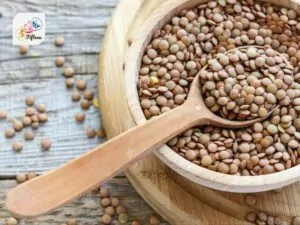
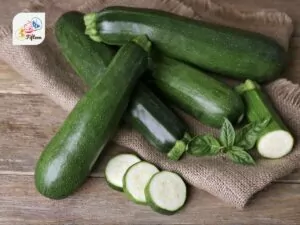
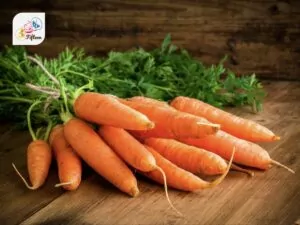
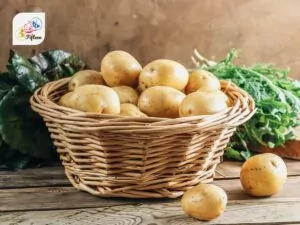
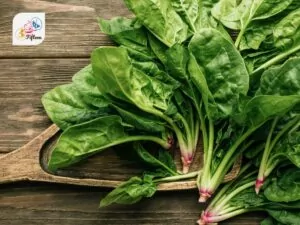
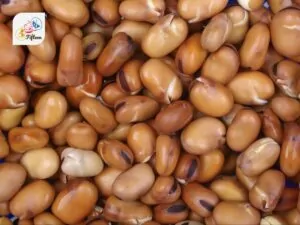
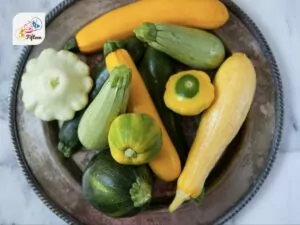
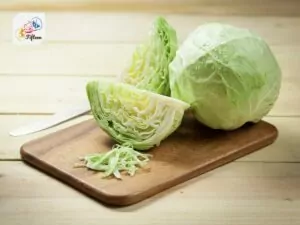
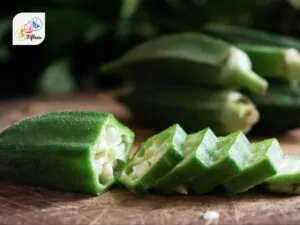
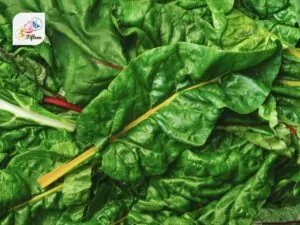
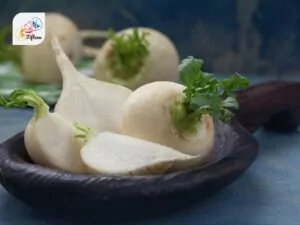
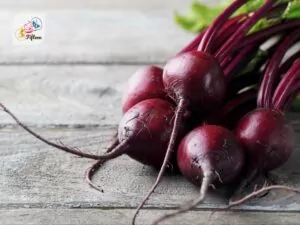
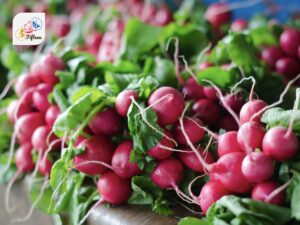
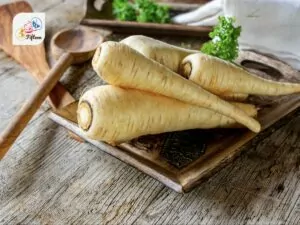
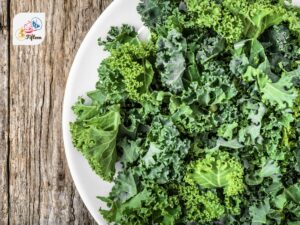
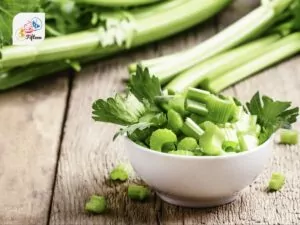
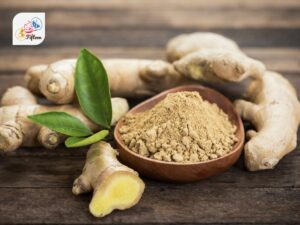
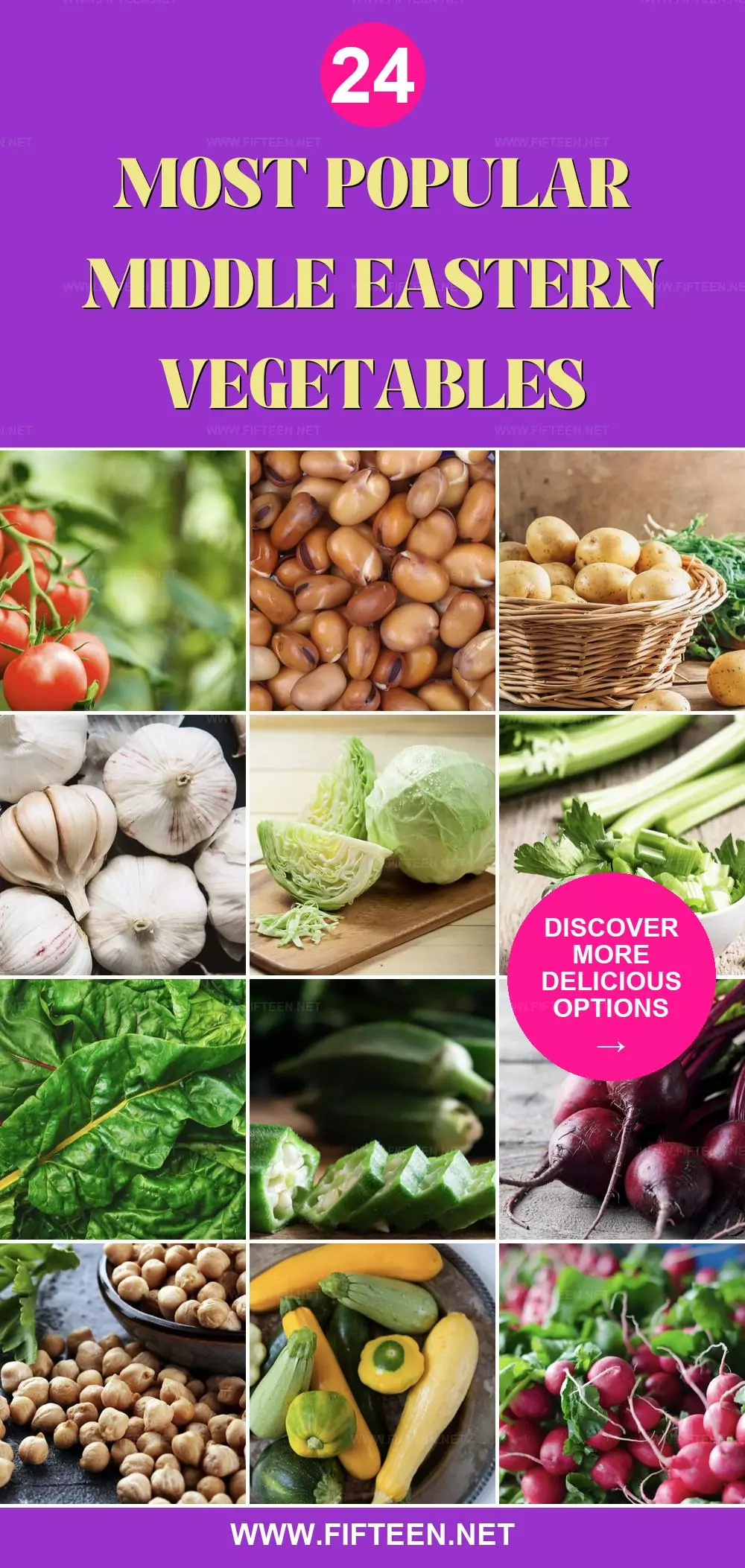
Jamie Scott
Editor in Chief, Senior Content Writer
Expertise
Home Cooking, Meal Planning, Recipe Development, Baking and Pastry, Food Editor, Cooking-video Maker, Western Food Evaluation Expert
Education
Le Cordon Bleu College of Culinary Arts
Local Community College, New York, NY
Jamie Scott is a skilled culinary expert and content creator specializing in Western cuisine. With over 15 years in the culinary field and formal training from Le Cordon Bleu, Paris, Jamie deeply understands how to blend nutrition with delicious flavors. His passion for cooking matches his commitment to making healthy eating accessible and enjoyable.
On Fifteen.net, Jamie brings a fresh perspective to classic dishes and beverages, offering readers insightful recipes, cooking tips, and a fresh view on meal planning that emphasizes taste, health, and simplicity.